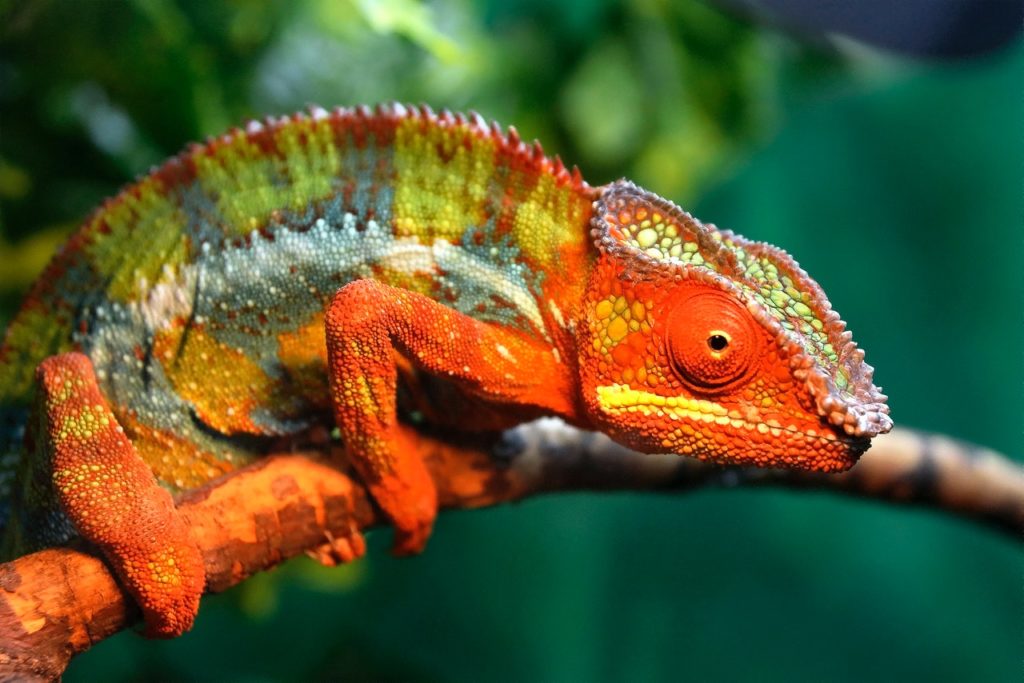
I learned this today. There are different ways that animals can change their colors. Some of the ways take days and some of them take seconds.
Let’s look at the slow way first. Some animals change their color very slowly. Some do it by completely shedding their fur. These are mostly mammals or birds that live in places where it snows. The Arctic hare, for example. It is brown and gray in the summer but it sheds all of its fur and regrows a completely white coat in time for the winter. This is so that it blends in with the earth and rocks in the summer and the snow in the winter.
The goldenrod crab spider can change from white to yellow, but it takes it about 20 days. It is a white spider, but it can secrete a yellow pigment into the outer shell layer of its body. They usually hunt on white or yellow flowers and change their color to match the flower. It takes them a long time because they cannot produce the yellow pigment very quickly.
Chameleons can change their color much faster than mammals, but it still takes them about half a minute. They use cells called iridophores. These are a type of color-changing cell. There are different types of color-changing cell and they are all grouped under the label chromatophore. Iridophores are plates that contain the reflective chemical guanine. Chameleons have two layers of these plates that are under the outer pigment layer of their skin. They can move them by tiny amounts to create gaps and to reflect different wavelengths of light up through the pigment layer. This changes their color. How they control it is a mystery. They use it for camouflage, but they also use it for communicating. When they excite the guanine, their skin reflects longer light wavelengths. That means, when they are relaxed, they are usually blue or green, and when they are excited, they are yellow, orange, or red. They can use this to communicate. When two chameleons face each other to fight, they will first have a color fight, and the brighter, redder, chameleon will probably win. The loser will signal this by turning green or blue. This saves them having to have a real fight.
Cephalopods, like octopus and squid, can change their colors pretty much instantly. They can also change their body shape. Octopuses (I know octopi is the plural – but I prefer octopuses) change their color using chromatophores. Their chromatophores contain a tiny sac filled with red, orange, brown, yellow, or black pigment. These sacs are attached to their central nervous system and they can stretch them at will. When they stretch them, they can change the concentrations of the pigment to make it darker or lighter. They also have a layer of iridophores underneath this layer of chromatophores. This lets them reflect different wavelengths of light back up through the chromatophores where they can alter the brightness of the light. Mixing both of these layers allows them to make any color. A third layer beneath the iridophores gives them another layer of protection. These are leucocytes. They also reflect light, but they diffuse it in all directions. That means that the octopus can look the same color from any angle that it is viewed from.
Octopus have another trick up their sleeves. They can use small bundles of muscles called papillae to change their texture. These muscles form a network and the octopus can selectively control them. It can smooth areas or raise areas of its skin to mimic coral, rocks, or whatever its surrounding area looks like.
One interesting thing is that octopuses are able to recreate the colors of their background in seconds but they cannot actually see it. Octopuses are colorblind and see the world in shades of gray. They are able to recreate the colors that in front of them because they can feel them. They have chemicals in their tentacles called opsin that can detect the wavelength being reflected by different colors. They also may have the ability to focus on different colors in different ways. It seems that white is blurry to them, but different wavelengths are sharper in different amounts. This means that they may be able to see wavelengths rather than see colors.
So, some animals change their color by shedding their fur and growing new fur. Some animals, such as chameleons, have the ability to reflect light back in different wavelengths, but it takes them about 30 seconds to do. And some animals, like octopuses, can change their color instantly and can make mixed colors. They use one layer to scatter light, one layer to reflect light in different wavelengths, and one layer to make it brighter or darker. And this is what I learned today.
Photo by Сергей Сёмин from Pexels
Sources
https://www.economist.com/the-economist-explains/2015/03/12/how-animals-change-colour
https://www.nationalgeographic.com/animals/article/color-change-camouflage-animals-explained
https://en.wikipedia.org/wiki/Chromatophore
https://theconversation.com/how-do-chameleons-and-other-creatures-change-colour-13842
https://animals.howstuffworks.com/animal-facts/animal-camouflage.htm
https://en.wikipedia.org/wiki/List_of_animals_that_can_change_color
https://en.wikipedia.org/wiki/Misumena_vatia
https://www.aquarium.co.za/blog/entry/how-does-an-octopus-change-its-colour-and-shape
https://en.wikipedia.org/wiki/Chameleon
https://ocean.si.edu/ocean-life/invertebrates/how-octopuses-and-squids-change-color

